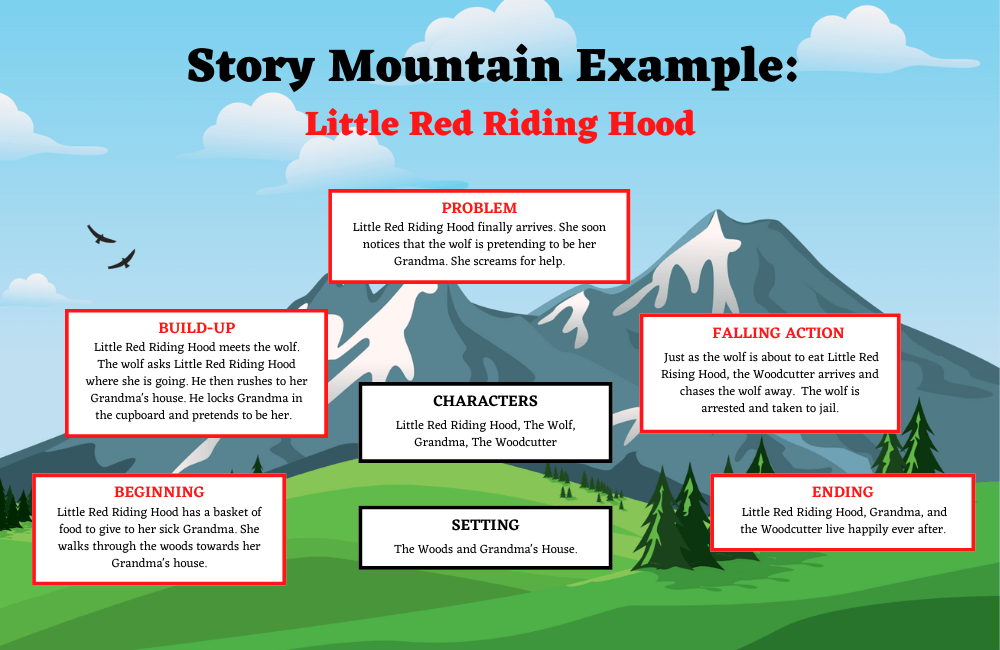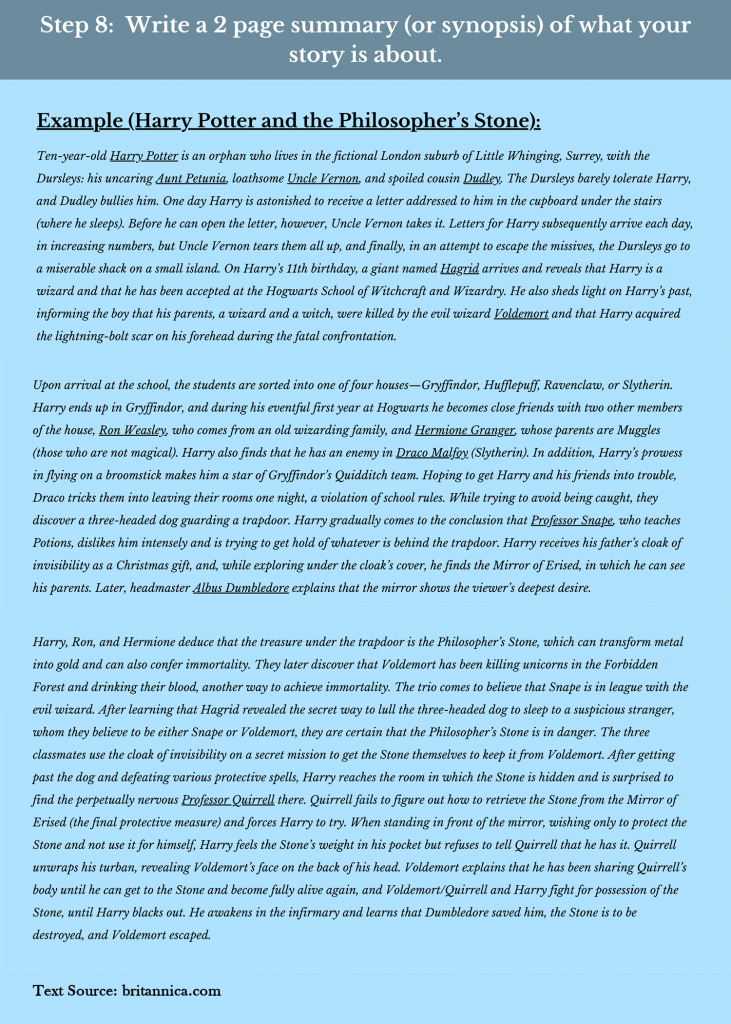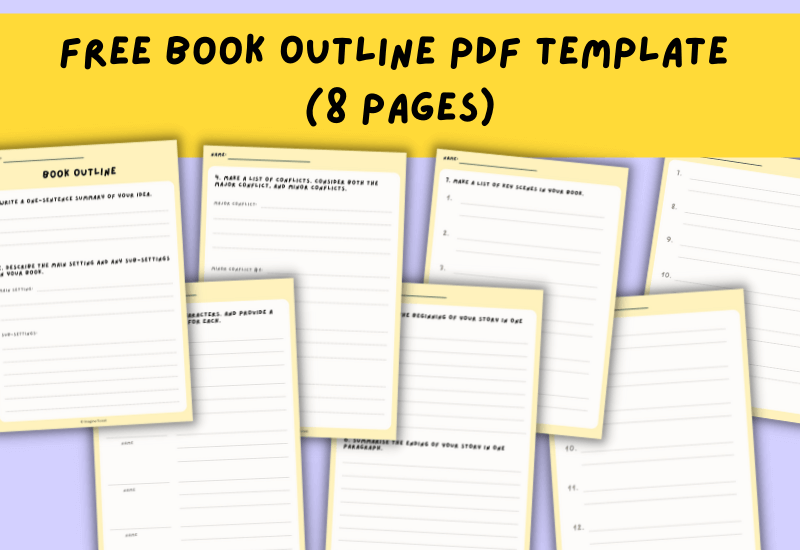How To Outline A Book [Free Outline Template]
Learn how to outline a book in seven easy steps. Don’t rush off and write a book yet! Wait a moment, and explore your book idea in detail. Is it interesting enough? Will there be any gaps in the plot? Can my readers understand it? You won’t know the answers to these questions unless you create a book outline. Whether you’re writing a picture book or a novel, a book outline can definitely help structure your ideas, so they make sense to you and your readers.
What Is A Book Outline
A book outline provides a list of events in a novel. This list of events includes the beginning, middle and end of a story. It can also include character overviews, plot twists and information about major conflicts. The purpose of a book outline is to help you structure your ideas in a logical format that makes sense to readers. Book outlines can also be called blueprints or plans, as these documents all help organise your ideas.
There are many different types of book outlines that authors use when planning or outlining their stories. The most popular method, you may have learned at school is the story mountain. A typical story mountain breaks your idea down into five parts. These different parts add structure to your idea, making it easier to write your first draft. Another technique used by authors is the snowflake method. This method takes a simple idea and keeps on adding to it until it forms an outline or even a basic draft of your story.
Of course, there are many other ways to outline your book, such as mind-mapping, scene lists, timelines, the three-act structure and even jotting down notes in a notebook. There is no formal method or technique for outlining books – Just do whatever you’re most comfortable with. And if you’re not sure where to begging, then this post will show you how to outline a book in seven, simple steps. Keep on reading!
How To Outline A Book in 7 Steps
The book outlining process is a very important step in story writing. Here are seven steps to outline your novel or story:
1. Write down your idea.
In at least one or two sentences summarise your story idea. It is essential that you summarise your idea in the fewest words possible. This way you can strip away any unnecessary or irrelevant ideas. If you can’t come up with an idea, then take a look at this guide on how to come up with good story ideas. Here are some examples of one-sentence summaries:
- A shy girl embarks on a journey to be an award-winning rapper.
- An extraterrestrial lifeform comes to Earth in search of an ancient artefact.
- A retired detective is forced to return to work when his daughter is murdered.
2. Describe the setting.
Your story may have one main setting, along with multiple sub-settings. The main setting is normally the overall mood of the story. While the sub-settings are specific locations and time periods. In this step, you should first provide a short summary of the main setting. Then you can list out any sub-settings if relevant. Here is an example to help you:
- Idea Summary: A shy girl embarks on a journey to be an award-winning rapper.
- Main Setting: Quiet, boring, humble beginnings to exciting, wild and reckless moments.
- Sub-Settings: Quiet small town of Brecon in Wales. Dark, dingy club in London, High-class experience at the Royal Albert Hall. World travel to popular music venues in New York, Paris, Tokyo, Dubai, Bangkok and Barcelona.
3. List out your characters.
Make a list of all the main characters in your story. This includes your hero, sidekicks and any bad guys or villains. For each character, you can create a short profile summary to describe their personality and role in the story. Here’s an example based on our previous story idea:
- Idea Summary: A shy girl embarks on a journey to be an award-winning rapper.
- Sonia Thomas [Main Character]: Very shy, rarely speaks. She recently left high school with few qualifications. She has a unique quirk: Whenever she gets into an argument or disagrees with someone she starts rapping about the subject. At first, she feels embarrassed, and like a ‘freak. But then as the story goes on she finds more and more confidence in herself and her talent.
4. Make a list of conflicts.
Every story has some sort of conflict. This conflict could internal, within the main character themself, or from external forces or characters. Most novels have one major conflict, and a set of smaller, minor conflicts. Your task here is to list and briefly describe the key conflicts you plan to have in your story. Here is an example:
- Idea Summary: A shy girl embarks on a journey to be an award-winning rapper.
- Major Conflict: Internal conflict – Sonia is scared of leaving her home village. She has never left this village in her whole life and hates changes. She just wants to pass through life invisible. But deep down inside, a voice is shouting out for attention on a global scale.
- Minor conflict #1: Sonia’s parents are constantly comparing her to other girls her age. This leads to an argument between these characters.
- Minor conflict #2: A boy Sonia had a crush on at school makes fun of her unique talent to rap during arguing.
5. Summarise the beginning.
Take everything you learned so far about your idea, and summarise the beginning. In just one paragraph, write down how the story will start. Avoid going into the major conflict, just introduce the main characters and the setting. Here is our example beginning summary:
- Idea Summary: A shy girl embarks on a journey to be an award-winning rapper.
- Beginning Summary: The location of Brecon in Wales will be described in detail as a quiet, humble village. Sonia, the main character will be introduced along with both her parents who are sheep farmers. An argument between mother and daughter shows that her mother is ashamed of her daughter. Their relationship has been broken ever since Sonia’s sister passed away. Sonia’s one passion in life is rap music, this is demonstrated by the items in her bedroom. Sonia’s dialogue at the beginning is limited to basic answers, such as ‘yes’, ‘maybe’ and shrugs.
6. Summarise the ending.
Flash forward in your mind to where your story will end. How to imagine it ending? Will it be a happy, sad or cliffhanger ending? Now in just one paragraph summarise the ending of your story. Here is our example ending summary:
- Idea Summary: A shy girl embarks on a journey to be an award-winning rapper.
- Ending Summary: Sonia is shown in the future 5 years from the beginning of the story. She is dating a childhood friend. They are both far from home, it an apartment in New York. Sonia gets a phone call from a music agent who asks her when she will be free to collaborate with a very famous rapper. The story ends here, leaving the reader with a warm feeling that Sonia’s new life is just about to begin.
7. Create a scene list.
With a better understanding of your idea, you can now list out the key events or moments in the story. This step can be very overwhelming, but to keep things simple, just focus on the beginning, middle and ending events. From there you should be able to list out more and more scenes in your story. You could even use a free storyboard template to organise your scenes. Here is an example of our scene list:
- Idea Summary: A shy girl embarks on a journey to be an award-winning rapper.
- Scene #1: A group of farmers are herding sheep on a farm.
- Scene #2: Marbella shouts her daughter’s name, Sonia from a small kitchen.
- Scene #3: Sonia is locked inside her bedroom with some loud hip-hop tunes playing in her headphones.
- Scene #4: An angry Marbella comes running up the stairs mumbling to herself about her useless daughter. She starts banging on her daughter’s bedroom door.
- Scene #5: Sonia finally hears something and runs to open the bedroom door.
By following the seven steps above, you should have a detailed book outline. Now you can use this book outline to help draft your story.
Reasons to Outline Your Book
A book outline turns a complicated story idea into a well-structured plan. Simply put, without an outline, you could be jumping between multiple ideas and end up with a draft that makes little sense. But having a good structure isn’t the only benefit. Here are some benefits of creating a book outline:
- Quicker draft writing: A detailed outline shows exactly how to begin and start writing your draft story. Whenever you’re stuck, just go back to your outline and see your next steps listed.
- Overcome writer’s block: Writer’s block is all about lacking motivation, or even inspiration to keep on writing. An outline makes the process of writing a novel feel less cumbersome or heavy-loaded. With all the key scenes summarised you can simply just add more detail to start forming your draft story.
- Avoid gaps and missing information: An outline highlights any gaps or areas of research needed. This makes for a better story, as you have researched every key element to make sure it makes sense and connects with each other.
- Logical structure: An idea on its own can go so many different ways. An outline helps you stay focused on the true moral of your story, without getting sidetracked with unnecessary pieces of information.
- Better plot twists: When you have a complete understanding of your story, you can easily add in twists that keep your reader hooked. And even switch out certain scenes for ones that might be more exciting.
- Clearer ideas: Book outlines help you visualise a story better by writing key elements down. This helps writers see the end goal much more clearly. Instead of messing about, or being stuck at the beginning.
There are many benefits to creating a book outline. The biggest benefit relates to story structure. This makes the outlining process crucial for every writer.
Book Outline Examples
Here are some book outline examples to inspire your novel outlining process.
- A story mountain outline for Red Riding Hood:

- 2 page summary of Harry Potter and the Philosopher’s stone using the Snowflake method:

- A basic mind map for the story of Cinderella:

Of course, you don’t need to follow a formal, well-noted structure. Bullet points, notes and sketches are also brilliant ways of outlining your novel.
Free Book Outline Template
Using our seven steps above, we have created this free book outline template. The purpose of this template is to help you expand your story idea into a fully developed story plot and outline. Simply print this template out and fill it out for your own story idea:

Common Questions About Story Outlines
Book outlines can be confusing. We searched the internet and found the following commonly asked questions about book outlines.
What are the 7 steps to outline a novel?
The 7 steps to outline a novel include:
- Write down your idea
- Describe the setting
- Make a list of characters
- List your conflicts
- Summarise the beginning
- Summarise the ending
- Make a scene list
Each of these steps has been explained in detail above.
How do you outline a book quickly?
The quickest way to outline your book is by breaking it down into smaller parts. There are a number of different ways to break down a story idea. The best way is to consider the different story elements, which include characters, settings, plot, conflict, resolution and theme. If you break down your idea into these different categories, you’ll find it a lot faster and easier to outline a novel, no matter how long it is.
What does it mean to outline a book?
To outline a book means to plan or map out the key events in the book. The book outline is like the skeleton of a story. Without it, your story would just be a bunch of ideas with no structure or cohesion. When you outline a novel, you are essentially noting down the important elements of it, such as characters, conflict and plot.
How do you outline a story step by step?
To outline a story step-by-step you need to begin with a story idea. From there you can expand on the details to create a complete outline. You can break down the outlining process in the following steps:
- Write down your idea
- Describe the setting
- Make a list of characters
- List your conflicts
- Summarise the beginning
- Summarise the ending
- Make a scene list
We have explained each of these steps in the section above.
How long does it take to outline a novel?
The book outlining process can take hours, days, weeks or months. This all depends on the size of your novel. If you’re writing a short picture book, then the book outline could take as little as a few hours. However, if you’re writing a big novel with 15 to 18 chapters then the whole outlining process could take months. You could even break this process down by outlining each chapter, which may be more manageable. In this case, outlining a chapter may take around a day or two. Check out our chapter book creator to write your own novel online.
If you still have a question about the book outlining process, let us know in the comments below. And we’ll happily answer those for you!






Comments loading...